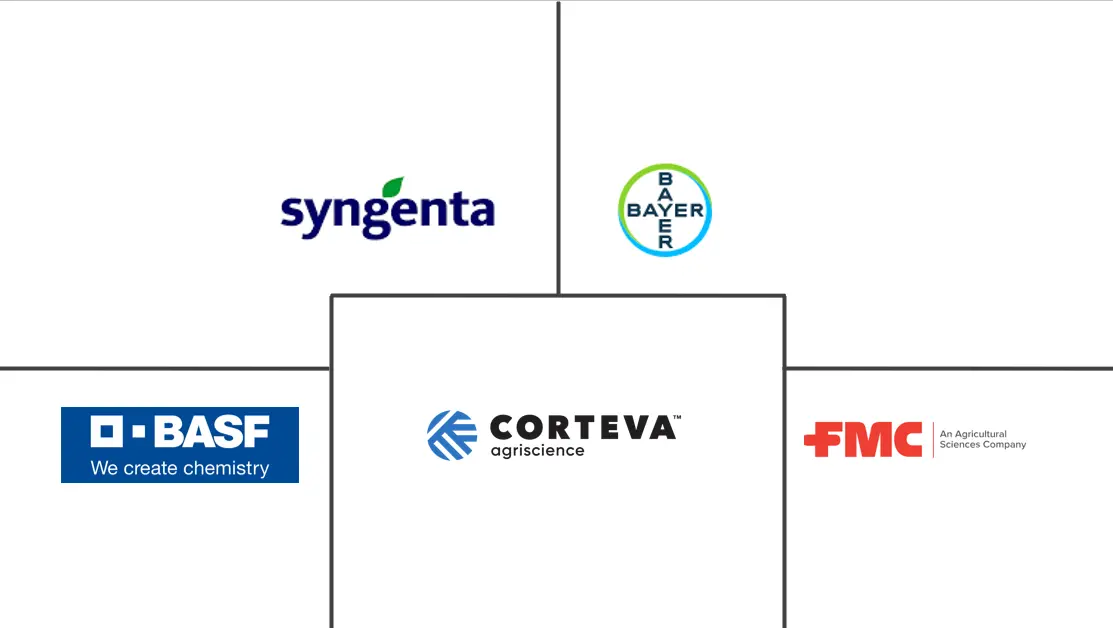Market Size of Brazil Seed Treatment Industry

| Study Period | 2019 - 2029 |
| Base Year For Estimation | 2023 |
| Market Size (2024) | USD 1.98 Billion |
| Market Size (2029) | USD 2.36 Billion |
| CAGR (2024 - 2029) | 4.50 % |
| Market Concentration | High |
Major Players
*Disclaimer: Major Players sorted in no particular order |
Brazil Seed Treatment Market Analysis
The Brazil Seed Treatment Market size is estimated at USD 1.98 billion in 2024, and is expected to reach USD 2.36 billion by 2029, growing at a CAGR of 4.5% during the forecast period (2024-2029).
Soybeans, maize, sugar cane, wheat, beans, coffee, and rice represent the primary crops cultivated on a large scale. However, they are also highly vulnerable to seed and soil-borne diseases and insect pests, which can hinder crop emergence and growth. Seed treatment methods prove highly effective in managing these early-growing diseases and controlling insect pests.
The major driving factors for the market are the increasing adoption rate of genetically engineered seeds in the country and the rising production level of quality soybean for domestic consumption (human and livestock) and the export market. These factors boosted the seed treatment market in Brazil in the past few years.
The market share analysis of the study concluded that the market was consolidated with a few international players occupying a major portion of the market through a diverse product portfolio. Some of the major players in the Brazilian seed treatment industry include Syngenta, Bayer CropScience, BASF SE, Corteva Agriscience, and Nufarm Limited, among others.
Brazil Seed Treatment Industry Segmentation
Seed treatment is a process where chemicals are used to treat or dress seeds prior to planting. For the purpose of the study, the seed treatment market has been broadly segmented into application and crop type. The report presents a detailed analysis of the share, size, and volume of the seed treatment market in Brazil. The corporations in the market operate in both the B2B and B2C format.
| Function | |
| Insecticide | |
| Fungicide | |
| Nematicide |
| Crop Type | |
| Commercial crops | |
| Fruits and Vegetables | |
| Grains and Cereals | |
| Pulses and Oilseeds | |
| Turf and Ornamentals |
Brazil Seed Treatment Market Size Summary
The Brazil seed treatment market is poised for significant growth, driven by the increasing adoption of genetically engineered seeds and the rising production of quality soybean for both domestic and export markets. As one of the largest agricultural producers globally, Brazil has seen a substantial rise in the area under genetically modified crops, such as cotton, soybean, and corn. This expansion provides a fertile ground for the seed treatment market to thrive, as the demand for advanced seed treatment products grows to support the cultivation of these crops. The market is characterized by a few dominant international players, including Syngenta, Bayer CropScience, BASF SE, and Corteva Agriscience, who leverage their diverse product portfolios to maintain a significant market share. These companies are actively engaged in strategic partnerships and product launches to enhance their presence and capture a larger share of the market.
The seed treatment industry in Brazil is further bolstered by the country's competitive export market, particularly for soybeans, which are a major crop. The devaluation of the Brazilian Real against the US Dollar is expected to increase soybean prices, encouraging higher production levels. Additionally, the growing demand for high-quality domestic ingredients for livestock feed is anticipated to drive soybean production, benefiting the seed treatment market. Companies like BASF have introduced innovative solutions, such as Bomvoro, to meet this demand. The market's consolidation is evident through various strategic moves, including acquisitions and R&D investments, aimed at enhancing product offerings and expanding market reach. Notable developments include Bayer's partnership with Novozymes to launch on-farm seed treatments and Ihara's introduction of fungicidal seed treatment products, highlighting the dynamic nature of the Brazilian seed treatment market.
Brazil Seed Treatment Market Size - Table of Contents
-
1. MARKET DYNAMICS
-
1.1 Market Overview
-
1.2 Market Drivers
-
1.3 Market Restraints
-
1.4 Porters Five Force's Analysis
-
1.4.1 Threat of New Entrants
-
1.4.2 Bargaining Power of Buyers/Consumers
-
1.4.3 Bargaining Power of Suppliers
-
1.4.4 Threat of Substitute Products
-
1.4.5 Intensity of Competitive Rivalry
-
-
-
2. MARKET SEGMENTATION
-
2.1 Function
-
2.1.1 Insecticide
-
2.1.2 Fungicide
-
2.1.3 Nematicide
-
-
2.2 Crop Type
-
2.2.1 Commercial crops
-
2.2.2 Fruits and Vegetables
-
2.2.3 Grains and Cereals
-
2.2.4 Pulses and Oilseeds
-
2.2.5 Turf and Ornamentals
-
-
Brazil Seed Treatment Market Size FAQs
How big is the Brazil Seed Treatment Market?
The Brazil Seed Treatment Market size is expected to reach USD 1.98 billion in 2024 and grow at a CAGR of 4.5% to reach USD 2.36 billion by 2029.
What is the current Brazil Seed Treatment Market size?
In 2024, the Brazil Seed Treatment Market size is expected to reach USD 1.98 billion.

